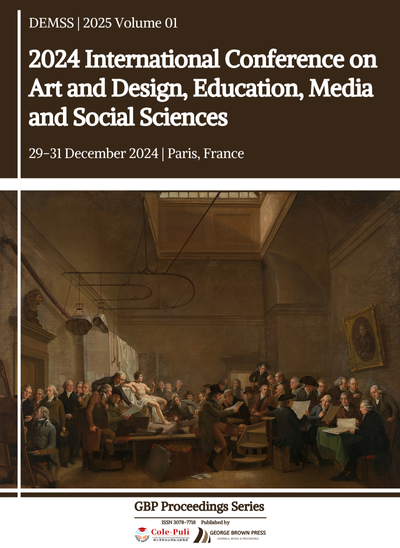The Impact of User-Generated Content on Brand Attitude and Purchase Intention in the Foreign-owned catering brand Domino’s Pizza in China
DOI:
https://doi.org/10.71222/x5y7rc74Keywords:
User-Generated Content (UGC), brand attitude, purchase intention, social media marketing, Domino’s PizzaAbstract
This study explores the impact of User-Generated Content (UGC) on brand attitude and purchase intention for the foreign-owned catering brand Domino’s Pizza in China. Based on four key UGC variables—usefulness, enjoyment, credibility, and interactivity—the research constructs a model through literature review and questionnaire analysis. The results indicate that usefulness and credibility significantly positively influence brand attitude, while interactivity and enjoyment show no significant impact. Brand attitude, in turn, significantly positively affects purchase intention. Additionally, using netnographic methods, the study examines the forms, content, and consumer engagement behaviors related to UGC on the social media platform "Xiaohongshu" (Red). It finds that UGC is predominantly presented as a combination of text and images, with content focusing on product recommendations, reviews, and promotional information. Consumers tend to trust UGC more than corporate advertisements, as this trust stems from the authenticity and non-commercial nature of UGC creators. The study recommends that companies emphasize the authenticity and usefulness of UGC, enhance brand awareness through high-quality content and active engagement, and ultimately boost purchase intentions.
References
1. D. A. Aaker and R. Jacobson, "The value relevance of brand attitude in high-tech markets," J. Mark. Res., vol. 38, no. 4, pp. 485-493, 2001, doi: 10.1509/jmkr.38.4.485.18905.
2. D. A. Aaker and K. L. Keller, "Consumer evaluations of brand extensions," J. Mark., vol. 54, no. 1, pp. 27-41, 1990, doi: 0.1177/002224299005400102.
3. M. Abzari, R. A. Ghassemi, and L. N. Vosta, "Analysing the effect of social media on brand attitude and purchase intention: The case of Iran Khodro Company," Procedia-Soc. Behav. Sci., vol. 143, pp. 822-826, 2014, doi: 10.1016/j.sbspro.2014.07.483.
4. A. Z. Bahtar and M. Muda, "The impact of UGC on product reviews towards online purchasing - A conceptual framework," Procedia Econ. Finance, vol. 37, pp. 337-342, 2016, doi: 10.1016/S2212-5671(16)30134-4.
5. H. Bhasin, "SWOT Analysis of Dominos," Marketing91, 2023. [Online]. Available: https://www.marketing91.com/swot-analysis-of-dominos/. [Accessed: Jun. 29, 2023].
6. H. J. Cheong and M. A. Morrison, "Consumers' reliance on product information and recommendations found in UGC," J. In-teract. Advert., vol. 8, no. 2, pp. 38-49, 2008, doi: 10.1080/15252019.2008.10722141.
7. J. F. Engel, P. W. Miniard, and R. D. Blackwell, Consumer Behavior, 8th ed. New York: Dryden Press, 1995.
8. J. Eighmey and L. McCord, "Adding value in the information age: Uses and gratifications of sites on the world wide web," J. Bus. Res., vol. 41, no. 3, pp. 187-194, 1998, doi: 10.1016/S0148-2963(97)00061-1.
9. D. R. Fortin and R. R. Dholakia, "Interactivity and vividness effects on social presence and involvement with a web-based advertisement," J. Bus. Res., vol. 58, no. 3, pp. 387-396, 2005, doi: 10.1016/S0148-2963(03)00106-1.
10. E. Goffman, The Presentation of Self in Everyday Life, C. Calhoun, J. Gerteis, J. Moody, S. Pfaff, and I. Virk, Eds., Contemp. Sociol. Theory. New York: Doubleday Anchor Books, 1959, pp. 46-61.
11. S. Hetcher, "User-generated content and the future of copyright: Part two-agreements between users and megasites," Santa Clara High Technol. Law J., vol. 24, no. 4, pp. 829-867, 2008.
12. E. Karahanna, D. W. Straub, and N. L. Chervany, "Information technology adoption across time: A cross-sectional compari-son of pre-adoption and post-adoption beliefs," MIS Q., vol. 23, no. 2, pp. 183-213, 1999, doi: 10.2307/249751.
13. R. V. Kozinets, Netnography: Redefined, 2nd ed. Sage, 2015.
14. R. V. Kozinets, K. De Valck, A. C. Wojnicki, and S. J. S. Wilner, "Networked narratives: Understanding word-of-mouth mar-keting on online communities," J. Mark., vol. 74, pp. 71-89, 2010, doi: 10.1509/jm.74.2.71.
15. B. K. Lewis, "Social media and strategic communication: Attitudes and perceptions among college students," Public Relat. J., vol. 4, no. 3, pp. 1-23, 2010.
16. C. Li and J. Bernoff, Groundswell: Winning in a World Transformed by Social Technologies. Boston, MA: Harvard Business Review Press, 2011.
17. S. W. Litvin, R. E. Goldsmith, and B. Pan, "Electronic word-of-mouth in hospitality and tourism management," Tourism Manag., vol. 29, pp. 458-468, 2008, doi: 10.1016/j.tourman.2007.05.011.
18. L. A. Mir and K. Rehman, "Factors affecting consumer attitudes and intention toward user-generated product content on YouTube," Manag. Mark. Challenges Knowledge Soc., vol. 8, no. 4, pp. 637-654, 2013.
19. M. Muda and M. I. Hamzah, "Should I suggest this YouTube clip? The impact of UGC source credibility on eWOM and pur-chase intention," J. Res. Interact. Mark., vol. 15, no. 3, pp. 441-459, 2021, doi: 10.1108/JRIM-04-2020-0072.
20. A. Muslim, S. Rezaei, and M. Abolghasemi, "User satisfaction with mobile websites: The impact of perceived usefulness (PU), perceived ease of use (PEOU), and trust," Nankai Bus. Rev. Int., vol. 5, no. 3, pp. 258-274, 2014., doi: 10.1108/NBRI-01-2014-0005.
21. S. Rahi, F. M. I. Alnaser, and M. Abd Ghani, "Designing survey research: recommendation for questionnaire development, calculating sample size and selecting research paradigms," Econ. Soc. Dev.: Book Proc., pp. 1158-1170, 2019.
22. A. Steckler, K. R. McLeroy, R. M. Goodman, S. T. Bird, and L. McCormick, "Toward integrating qualitative and quantitative methods: An introduction," Health Educ. Q., vol. 19, no. 1, pp. 1-8, 1992, doi: 10.1177/109019819201900101.
23. L. L. Thomala, "Social networks in China - statistics & facts," Statista, 2021. [Online]. Available: https://web.archive.org/web/20220124015937/https://www.statista.com/statistics/277586/number-of-social-network-users-in-china/. [Accessed: 20th June 2023].
24. A. K. Tripathi, "A taxonomy of user-generated content applications," 2020. [Online]. Available: https://papers.ssrn.com/sol3/papers.cfm?abstract_id=3662013#. [Accessed: 10th May 2023].
25. H. Yu, N. Xu, and T. Liu, "The development history and achievements of foreign-owned restaurants in China," Foreign Invest. China, vol. 7, pp. 102-104, 2022. [In Chinese].
26. J. Yu and E. Ko, "UGC attributes and effects: implication for luxury brand advertising," Int. J. Advert., vol. 40, no. 6, pp. 945-967, 2021, doi: 10.1080/02650487.2021.1898773.
27. L. Zhou and F. Xue, "Effects of Instagram user-generated content on travel inspiration and planning: An extended model of technology acceptance," J. Promot. Manag., vol. 28, no. 3, pp. 239-260, 2021, doi: 10.1080/10496491.2021.1989537.










